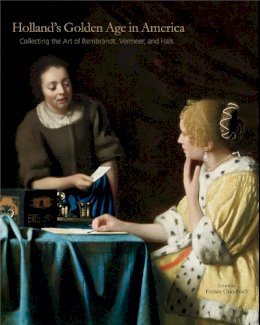16%OFF
Stock image for illustration purposes only - book cover, edition or condition may vary.
Holland’s Golden Age in America: Collecting the Art of Rembrandt, Vermeer, and Hals
Esmee Quodbach
FREE Delivery in Ireland
Description for Holland’s Golden Age in America: Collecting the Art of Rembrandt, Vermeer, and Hals
Hardback. Collecting the Art of Rembrandt Vermeer and Hals. Num Pages: NO. Dimension: 215 x 263 x 27. Weight in Grams: 1408.
Americans have long had a taste for the art and culture of Holland’s Golden Age. As a result, the United States can boast extraordinary holdings of Dutch paintings. Celebrated masters such as Rembrandt van Rijn, Johannes Vermeer, and Frans Hals are exceptionally well represented, but many fine paintings by their contemporaries can be found as well. In this groundbreaking volume, fourteen noted American and Dutch scholars examine the allure of seventeenth-century Dutch painting to Americans over the past centuries. The authors of Holland’s Golden Age in America explain in lively detail why and how American collectors as well as museums ... Read moreturned to the Dutch masters to enrich their collections. They examine the role played by Dutch settlers in colonial America and their descendants, the evolution of American appreciation of the Dutch school, the circumstances that led to the Dutch school swiftly becoming one of the most coveted national schools of painting, and, finally, the market for Dutch pictures today.Richly illustrated, this volume is an invaluable contribution to the scholarship on the collecting history of Dutch art in America, and it is certain to inspire further research.
In addition to the editor, the contributors are Ronni Baer, Quentin Buvelot, Lloyd DeWitt, Peter Hecht, Lance Humphries, Walter Liedtke, Louisa Wood Ruby, Catherine B. Scallen, Annette Stott, Peter C. Sutton, Dennis P. Weller, Arthur K. Wheelock, Jr., and Anne T. Woollett.
Show Less
Product Details
Publisher
Pennsylvania State University Press
Place of Publication
University Park, United States
Shipping Time
Usually ships in 7 to 11 working days
About Esmee Quodbach
Esmée Quodbach is Assistant Director of the Center for the History of Collecting at The Frick Collection and Frick Art Reference Library in New York.
Reviews for Holland’s Golden Age in America: Collecting the Art of Rembrandt, Vermeer, and Hals
“This book provides answers for anyone who has ever wondered why there are so many great Dutch paintings in U.S. collections. Essays by leading curators and scholars draw on the history of art, as well as an understanding of cultural, economic, and political conditions, to illuminate the American taste for seventeenth-century Dutch painting.” —Emilie Gordenker, Director, Mauritshuis, The Hague ... Read more“Drawing on the experience and insights of many of her colleagues in museums and the academy, Esmée Quodbach brings us an impressively broad overview of the early collectors of Dutch art in America. This essential volume provides illuminating context for major figures such as J. P. Morgan and welcomes unsung heroes such as Robert Gilmor, Jr., onto this stage, but also lifts the curtain on early colonial as well as contemporary collections. These varied accounts are spiked with color, drama, and highlights, including the story of the wealthy collector who has to ask, ‘Who is Vermeer?’” —David de Witt, Bader Curator of European Art, Queen’s University “Americans esteem Dutch art for its portrayal of the apparent reality of everyday life, unpretentious and tidy citizenry, and seemingly naturalistic landscapes and seascapes. This beautiful volume of authoritative essays on the collecting of Dutch art is not only for specialists but also for general readers, who will find many familiar names of businessmen who were the founders or enrichers of American museums. Foremost among these are the National Gallery, the Boston Museum of Fine Arts, the Metropolitan Museum of Art, and the Los Angeles County Museum of Art, as well as privately founded galleries—the Frick, the Morgan, and the Getty. Among the many topics discussed are the early presence of Dutch paintings in New Netherland, parallel appreciation for Vermeer and American painters of interiors, European-born scholars and dealers who helped shape American appreciation for the arts, the rivalry among collectors for the acquisition of declared masterpieces, and the usefulness and value of painted and printed copies for display and instruction. The acquisition of Dutch art is as much about the art as it is about social history.” —A. Golahny Choice Show Less

